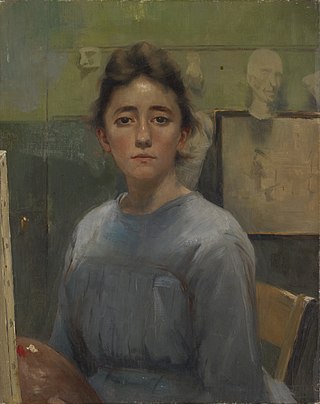
The World's Columbian Exposition, also known as the Chicago World's Fair, was a world's fair held in Chicago from May 5 to October 31, 1893, to celebrate the 400th anniversary of Christopher Columbus's arrival in the New World in 1492. The centerpiece of the Fair, held in Jackson Park, was a large water pool representing the voyage that Columbus took to the New World. Chicago won the right to host the fair over several competing cities, including New York City, Washington, D.C., and St. Louis. The exposition was an influential social and cultural event and had a profound effect on American architecture, the arts, American industrial optimism, and Chicago's image.

Erich Julius Adolf Bethe was a German classical philologist who was a native of Stettin.

Ida Eléonora Davida von Schulzenheim (1859–1940) was a Swedish painter. Her foremost motif was paintings of animals.

Ottilie Wilhelmine Roederstein was a German-Swiss painter. She was the long-time companion of Elisabeth Winterhalter, one of the first female doctors in Germany.
Annie Mary Youngman was a British painter.

Frances Miller Mumaugh was an American still-life painter. She exhibited an oil, A Dreamer, at the World's Congress of Representative Women of the World's Columbian Exposition in Chicago, 1893; and was also an exhibitor at the Louisiana Purchase Exposition, 1904.

The Woman's Building was designed and built in June of 1892, for the World's Columbian Exposition held in Chicago in 1893; under the auspices of the Board of Lady Managers. Out of the twelve main buildings for the Exhibition, the Woman's Building was the first to be completed. It had an exhibition space as well as an assembly room, a library, and a Hall of Honor. The History of the World's Fair states, "It will be a long time before such an aggregation of woman's work, as may now be seen in the Woman's Building, can be gathered from all parts of the world again." The purpose of the building was to highlight woman's achievements, and challenge the traditional ways of thinking at the time it was built. The Woman's Building was planned, designed, and decorated entirely by women under the direction of the board of lady managers.

Margarethe Hormuth-Kallmorgen was a German painter. She was known for her flower painting.

Gertrud Staats (1859–1938) was a German painter and founder of Vereinigung Schlesischer Kűnstlerinnen. She was known for her landscapes.
Ida Cole Haskell was an American painter and educator. She is known for her landscape and genre paintings. She taught painting at the Pratt Institute.

Jeanne Royannez, also known as Madame Clovis Hugues (1855-1932) was a French sculptor.

Countess Maria von Kalckreuth (1857-1897) was a German painter known for her portraits.

Marie von Keudell (1838–1918) was a German painter known for her landscape painting.
Johanna Kirsch (1856-1907) was a German painter known for her portrait and genre paintings.
Hildegard Lehnert (1857-1943) was a German painter.
Clara Augusta Amalie Emma Lobedan (1840–1918) was a German painter, watercolorist, pastelist, ceramicist, and craftsman.
Auguste Ludwig (1834-1901) was a German genre painter.
Bertha Schrader was a German painter, lithographer, and woodblock print-maker.
Minna Stocks (1846-1928) was a German painter known for her animal paintings.

Augusta Charlotte Cornelie Roszmann (1859–1945) was a Belgian artist.













